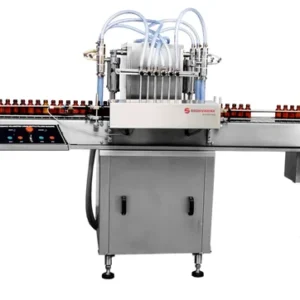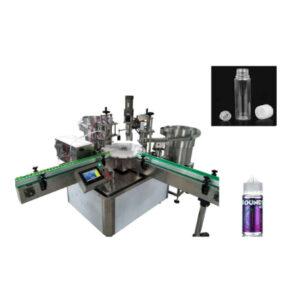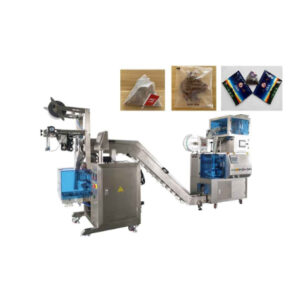Description
A vial filling machine is a crucial piece of equipment in pharmaceutical, biotechnology, and other industries where precise liquid filling is required. These machines are designed to efficiently fill vials with liquids such as medications, vaccines, serums, and other solutions, ensuring accurate dosage levels and minimizing wastage.
Typically, vial filling machines employ advanced technology to automate the filling process, reducing human error and increasing production efficiency. They are equipped with features such as peristaltic pumps, syringes, or piston pumps to precisely measure and dispense the desired volume of liquid into each vial.
The design of vial filling machines can vary depending on factors such as the type of liquid being filled, production volume, and required level of automation. Some machines are capable of filling multiple vials simultaneously, while others are designed for smaller-scale operations.
In addition to filling, these machines may also perform other tasks such as capping, labeling, and inspection to ensure product quality and compliance with regulatory standards. Overall, vial-filling machines play a crucial role in streamlining the manufacturing process for pharmaceutical and biotech products, contributing to increased efficiency, accuracy, and safety in the production of essential medications and treatments.
Understanding the Vial Filling Machine
In the pharmaceutical industry, precision and efficiency are paramount. The demand for accurate dosage levels and sterile conditions drives the need for advanced equipment, such as automatic vial-filling machines. These machines play a pivotal role in the pharmaceutical vial filling process, ensuring precise measurements and sterile conditions to maintain product quality and safety.
Automatic Vial Filling Machines
Automatic vial filling machines are at the forefront of pharmaceutical manufacturing, offering a seamless solution for filling vials with various liquid medications, vaccines, and solutions. These machines are designed to automate the filling process, significantly reducing human error and increasing production efficiency.
Equipped with sophisticated technology, automatic vial filling machines utilize different mechanisms such as peristaltic pumps, syringes, or piston pumps to precisely measure and dispense the desired volume of liquid into each vial. This level of precision is essential in pharmaceutical production, where even minor deviations can impact the efficacy and safety of the final product.
Ensuring Sterility
Sterility is a critical concern in pharmaceutical manufacturing, particularly when it comes to injectable medications and vaccines. Sterile vial filling machines are specifically designed to maintain a sterile environment throughout the filling process, minimizing the risk of contamination and ensuring product integrity.
These machines feature advanced sterilization methods, such as steam sterilization or sterile filtration, to eliminate microbial contaminants and maintain aseptic conditions within the vial filling equipment. Additionally, sterile vial filling machines are equipped with safeguards to prevent contamination from external sources, such as dust or airborne particles, further enhancing product safety.
Efficiency and Precision
The use of vial filling equipment offers numerous benefits to pharmaceutical manufacturers. Firstly, these machines significantly improve production efficiency by automating repetitive tasks and reducing the time required for filling vials manually. This increased efficiency translates to higher output and faster time-to-market for critical medications and treatments.
Moreover, vial filling equipment ensures unparalleled precision in dosage measurements, minimizing variations between individual vials and enhancing product consistency. This level of precision is particularly crucial in pharmaceuticals, where the efficacy and safety of medications rely on accurate dosage administration.
Integration into Vial Filling Lines
Vial filling machines are often integrated into larger vial filling lines, which encompass additional equipment for tasks such as capping, labeling, and inspection. This integration streamlines the manufacturing process, allowing for seamless transitions between different stages of production and reducing the risk of errors or delays.
By incorporating vial filling machines into comprehensive filling lines, pharmaceutical manufacturers can achieve greater automation and standardization in their production processes. This not only improves overall efficiency but also enhances quality control measures, ensuring that every vial meets stringent regulatory standards before reaching the market.
Types of vial filling machine
1. Automatic Vial Filling Machines
Automatic vial filling machines are the most advanced and widely used type in pharmaceutical manufacturing. These machines are fully automated, and capable of filling vials with precision and efficiency. They utilize advanced technology such as peristaltic pumps, syringes, or piston pumps to accurately measure and dispense liquid into each vial. Automatic vial-filling machines streamline production processes, reduce human error, and increase throughput, making them ideal for high-volume production environments.
2. Semi-Automatic Vial Filling Machines
Semi-automatic vial filling machines combine automation with manual intervention. While some aspects of the filling process are automated, such as liquid dispensing, other tasks may require manual assistance, such as vial loading and unloading. These machines are suitable for smaller-scale production or for applications where flexibility and cost-effectiveness are priorities.
3. Sterile Vial Filling Machines
Sterile vial filling machines are specifically designed to maintain a sterile environment throughout the filling process. They incorporate advanced sterilization methods, such as steam sterilization or sterile filtration, to eliminate microbial contaminants and ensure product integrity. Sterile vial filling machines are essential for the production of injectable medications and vaccines, where sterility is critical to patient safety.
4. Peristaltic Vial Filling Machines
Peristaltic vial filling machines utilize a peristaltic pump mechanism to dispense liquid into vials. In this type of machine, the liquid is drawn through a flexible tube by the rotating action of rollers, which compress the tube and push the liquid forward. Peristaltic vial filling machines are known for their accuracy and versatility, making them suitable for a wide range of liquid viscosities and formulations.
5. Rotary Vial Filling Machines
Rotary vial filling machines are designed to fill multiple vials simultaneously, typically arranged in a circular configuration on a rotary platform. These machines offer high-speed filling capabilities and are often used in large-scale production facilities where efficiency is paramount. Rotary vial filling machines can be customized to accommodate different vial sizes and configurations, making them versatile solutions for diverse production needs.
Applications of vial filling machine
1. Pharmaceutical Production
One of the primary applications of vial filling machines is in pharmaceutical manufacturing. These machines play a crucial role in filling vials with liquid medications, including injectables, oral suspensions, and ophthalmic solutions. The precise dosing and sterile conditions provided by vial filling machines ensure the quality, safety, and efficacy of pharmaceutical products, meeting regulatory requirements and industry standards.
2. Vaccine Production
Vial filling machines are indispensable in the production of vaccines, where accuracy and sterility are paramount. These machines are used to fill vials with vaccine formulations, including live attenuated vaccines, inactivated vaccines, and subunit vaccines. By maintaining sterile conditions and precise dosing, vial filling machines contribute to the production of safe and effective vaccines for immunization programs worldwide.
3. Biotechnology Research
In biotechnology research laboratories, vial-filling machines are utilized for the preparation and dispensing of reagents, buffers, and cell culture media. These machines ensure accurate volume dispensing, minimizing experimental variability and ensuring reproducibility in research outcomes. Vial-filling machines also support the automation of repetitive tasks, freeing up researchers’ time for more critical activities.
4. Diagnostic Test Kit Manufacturing
Vial filling machines play a crucial role in the manufacturing of diagnostic test kits used in healthcare settings. These machines fill vials with reagents, enzymes, or substrates required for various diagnostic assays, including immunoassays, molecular diagnostics, and clinical chemistry tests. The accuracy and precision of vial filling machines are essential for reliable test results and accurate disease diagnosis.
5. Cosmetic and Personal Care Products
Vial filling machines are employed in the production of cosmetic and personal care products, such as serums, lotions, and creams. These machines accurately dispense liquid formulations into vials or bottles, ensuring consistent product quality and dosage. Vial-filling machines enable cosmetic manufacturers to scale up production while maintaining efficiency and product integrity.
6. Veterinary Medicine Manufacturing
In the veterinary medicine industry, vial filling machines are used to fill vials with liquid medications for animals, including vaccines, antibiotics, and nutritional supplements. These machines ensure accurate dosing and sterility, meeting the specific requirements for veterinary pharmaceuticals. Vial filling machines support the production of veterinary medicines that contribute to animal health and welfare.
Functionalities of vial filling machine
1. Precise Liquid Dispensing
The primary function of a vial filling machine is to accurately dispense liquid into vials at predetermined volumes. These machines utilize various mechanisms such as peristaltic pumps, syringes, or piston pumps to ensure precise dosing, minimizing variations between individual vials and maintaining product consistency.
2. Automation
Vial-filling machines automate the filling process, reducing the need for manual intervention and minimizing human error. Automated systems control liquid dispensing, vial positioning, and other critical parameters, streamlining production workflows and increasing efficiency.
3. Sterility Maintenance
In pharmaceutical and biotechnology applications, maintaining sterility throughout the filling process is essential to ensure product safety and compliance with regulatory standards. Vial filling machines incorporate features such as sterile filtration, steam sterilization, or aseptic processing to prevent microbial contamination and maintain aseptic conditions within the equipment.
4. Flexibility and Versatility
Modern vial-filling machines are designed to accommodate a wide range of vial sizes, shapes, and materials, providing flexibility to manufacturers. Adjustable filling heads, customizable settings, and interchangeable parts allow for versatility in handling different types of liquid formulations and packaging requirements.
5. Integration with Production Lines
Vial-filling machines can be seamlessly integrated into larger production lines, facilitating the continuity of manufacturing processes. Integration with other equipment such as capping machines, labeling machines, and inspection systems enables a cohesive production workflow, reducing downtime and optimizing overall efficiency.
6. Quality Control and Assurance
Vial filling machines often incorporate built-in quality control features to ensure the accuracy and integrity of filled vials. These may include sensors for detecting fill levels, vision systems for inspecting vials for defects, and reject mechanisms for removing faulty vials from the production line. These quality control measures help maintain product quality and compliance with regulatory requirements.
7. Data Logging and Documentation
Many vial filling machines are equipped with data logging capabilities, allowing manufacturers to record critical process parameters such as fill volumes, fill speeds, and sterilization cycles. This data can be used for process optimization, troubleshooting, and regulatory documentation purposes, ensuring traceability and accountability throughout the manufacturing process.
Frequently Asked Questions
- What is a vial filling machine?
A vial filling machine is a specialized piece of equipment used in pharmaceutical and biotechnology industries to accurately fill vials with liquid medications, vaccines, or other solutions.
- How does a vial filling machine work?
Vial filling machines utilize various mechanisms such as peristaltic pumps, syringes, or piston pumps to precisely measure and dispense liquid into vials. The machine automates the filling process, ensuring accuracy and efficiency.
- What types of vial-filling machines are available?
Vial filling machines come in various types including automatic, semi-automatic, sterile, peristaltic, and rotary vial filling machines, each catering to specific production requirements and industry standards.
- What are the benefits of using a vial-filling machine?
The benefits of using a vial filling machine include increased production efficiency, precise dosage measurements, sterility maintenance, flexibility in handling different formulations, and integration with production lines for seamless workflows.
- How do I choose the right vial-filling machine for my needs?
When selecting a vial filling machine, consider factors such as production volume, type of liquid being filled, required level of automation, sterility requirements, and compatibility with other equipment in your production facility.
- What safety features should I look for in a vial-filling machine?
Look for vial-filling machines equipped with safety measures such as automatic stop mechanisms to prevent overfilling, safety guards to protect operators from moving parts, and fail-safe systems to minimize the risk of accidents.
- How do I maintain a vial filling machine?
Regular maintenance of a vial filling machine involves cleaning, lubricating moving parts, inspecting for wear and tear, and calibrating equipment to ensure accurate filling volumes. Follow manufacturer guidelines for specific maintenance procedures.
- Can a vial filling machine handle different vial sizes and types?
Yes, many vial-filling machines are designed to accommodate a range of vial sizes, shapes, and materials. Adjustable filling heads and customizable settings allow for flexibility in handling diverse packaging requirements.
- Are vial filling machines compliant with regulatory standards?
Yes, reputable vial filling machine manufacturers design their equipment to meet regulatory standards such as cGMP (Current Good Manufacturing Practice) and FDA (Food and Drug Administration) guidelines to ensure product quality and safety.
- How can I troubleshoot common issues with a vial filling machine?
Common issues with vial filling machines may include inconsistent filling volumes, clogging, or equipment malfunctions. Refer to the manufacturer’s manual for troubleshooting steps or consult with technical support for assistance in resolving specific issues.





